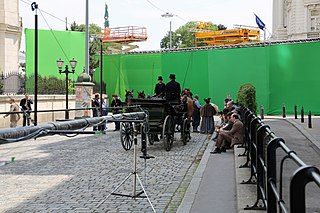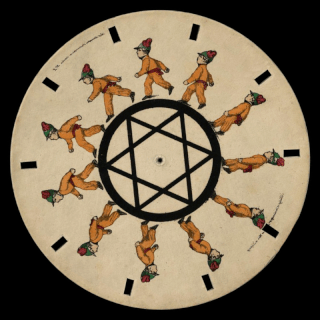
Animation is a method in which figures are manipulated to appear as moving images. In traditional animation, images are drawn or painted by hand on transparent celluloid sheets to be photographed and exhibited on film. Today, most animations are made with computer-generated imagery (CGI). Computer animation can be very detailed 3D animation, while 2D computer animation can be used for stylistic reasons, low bandwidth, or faster real-time renderings. Other common animation methods apply a stop motion technique to two and three-dimensional objects like paper cutouts, puppets, or clay figures.

Stop motion is an animated filmmaking technique in which objects are physically manipulated in small increments between individually photographed frames so that they will appear to exhibit independent motion or change when the series of frames is played back. Any kind of object can thus be animated, but puppets with movable joints or plasticine figures are most commonly used. Puppets, models or clay figures built around an armature are used in model animation. Stop motion with live actors is often referred to as pixilation. Stop motion of flat materials such as paper, fabrics or photographs is usually called cutout animation.

A zoetrope is one of several pre-film animation devices that produce the illusion of motion by displaying a sequence of drawings or photographs showing progressive phases of that motion. It was basically a cylindrical variation of the phénakisticope, suggested almost immediately after the stroboscopic discs were introduced in 1833. The definitive version, with easily replaceable picture strips, was introduced as a toy by Milton Bradley in 1866 and became very successful.

Special effects are illusions or visual tricks used in the theatre, film, television, video game, and simulator industries to simulate the imagined events in a story or virtual world.

Drawn-on-film animation, also known as direct animation or animation without camera, is an animation technique where footage is produced by creating the images directly on film stock, as opposed to any other form of animation where the images or objects are photographed frame by frame with an animation camera.
The history of animation started long before the development of cinematography. Humans have probably attempted to depict motion as far back as the paleolithic period. Much later, shadow play and the magic lantern offered popular shows with projected images on a screen, moving as the result of manipulation by hand and/or minor mechanics. In 1833, the stroboscopic disc introduced the stroboscopic principles of modern animation, which decades later would also provide the basis for cinematography. Between 1895 and 1920, during the rise of the cinematic industry, several different animation techniques were developed, including stop-motion with objects, puppets, clay or cutouts, and drawn or painted animation. Hand-drawn animation, mostly animation painted on cels, was the dominant technique throughout most of the 20th century and became known as traditional animation.
Visual effects is the process by which imagery is created or manipulated outside the context of a live action shot in filmmaking and video production. The integration of live action footage and other live action footage or CG elements to create realistic imagery is called VFX.

Clay animation or claymation, sometimes plasticine animation, is one of many forms of stop-motion animation. Each animated piece, either character or background, is "deformable"—made of a malleable substance, usually plasticine clay.

Traditional animation is an animation technique in which each frame is drawn by hand. The technique was the dominant form of animation in cinema until the advent of computer animation.

The phenakistiscope was the first widespread animation device that created a fluent illusion of motion. Dubbed Fantascope and Stroboscopische Scheiben by its inventors, it has been known under many other names until the French product name Phénakisticope became common. The phenakistiscope is regarded as one of the first forms of moving media entertainment that paved the way for the future motion picture and film industry. Like a GIF animation, it can only show a short continuous loop.

Cutout animation is a form of stop-motion animation using flat characters, props and backgrounds cut from materials such as paper, card, stiff fabric or photographs. The props would be cut out and used as puppets for stop motion. The world's earliest known animated feature films were cutout animations, as is the world's earliest surviving animated feature Die Abenteuer des Prinzen Achmed (1926) by Lotte Reiniger.

A flip book or flick book is a booklet with a series of images that very gradually change from one page to the next, so that when the pages are viewed in quick succession, the images appear to animate by simulating motion or some other change. Often, flip books are illustrated books for children, but may also be geared toward adults and employ a series of photographs rather than drawings. Flip books are not always separate books, but may appear as an added feature in ordinary books or magazines, frequently, using the page corners. Software packages and websites are also available that convert digital video files into custom-made flip books.

A stroboscope, also known as a strobe, is an instrument used to make a cyclically moving object appear to be slow-moving, or stationary. It consists of either a rotating disk with slots or holes or a lamp such as a flashtube which produces brief repetitive flashes of light. Usually, the rate of the stroboscope is adjustable to different frequencies. When a rotating or vibrating object is observed with the stroboscope at its vibration frequency, it appears stationary. Thus stroboscopes are also used to measure frequency.

Clutch Cargo is an American animated television series created by cartoonist Clark Haas and produced by Cambria Productions, and syndicated beginning on March 9, 1959. The series was notable for its limited animation yet imaginative stories, as well as for being the first widely-known use of Syncro-Vox technology. It was a surprise hit at the time, and could be seen on 65 stations nationwide in 1960.

Precursors of film are concepts and devices that have much in common with the later art and techniques of cinema.
Model animation is a form of stop motion animation designed to merge with live-action footage to create the illusion of a real-world fantasy sequence.
Smallgantics is a digital post production technique used for miniature faking – simulating miniature cinematography on full scale filmed sequences – created and developed by Bent Image Lab. The technique was inspired by the tilt-shift photography of Olivo Barbieri, and Ray Di Carlo's hands on observations while building photo real miniatures in Hollywood. Noticing that certain details had to be avoided when creating believable miniatures, Di Carlo pondered what could be achieved by introducing these same flaws into live action footage, virtually reversing the quality control process. After his initial tests, this technique was further developed by the Bent production team ,including VFX director Jim Clark, into a complex, hand matted motion process on multiple planes.

Holy Flying Circus (2011) is a 90-minute BBC television comedy film first broadcast in 2011, written by Tony Roche and directed by Owen Harris.

In Saturn's Rings is a large format movie about Saturn made exclusively from real photographs taken by spacecraft. Director Stephen van Vuuren used more than 7.5 million photographs and numerous film techniques to create the effect of flying through space around Saturn and among its rings. CGI and 3-D modeling were not used in any capacity to create the realistic feel van Vuuren wanted for the viewer's experience. Most of the photos were taken by various major space missions.

Barrier-grid animation or picket-fence animation is an animation effect created by moving a striped transparent overlay across an interlaced image. The barrier-grid technique originated in the late 1890s, overlapping with the development of parallax stereography (Relièphographie) for 3D autostereograms. The technique has also been used for color-changing pictures, but to a much lesser extent.

















